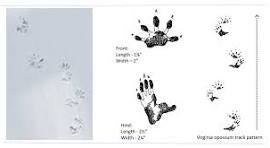Introduction: Opossum Footprint Identification
Opossums are among North America’s most misunderstood creatures, yet they play an essential role in balancing ecosystems. Learning the art of opossum footprint identification offers naturalists, homeowners, and wildlife enthusiasts a chance to understand these nocturnal marsupials more deeply. Their tracks tell a fascinating story and, with practice, can be distinguished from those of raccoons and other common backyard visitors.
Understanding the Opossum: A Brief Overview
Before diving into track identification, let’s look at the unique traits of the Virginia opossum, North America’s only marsupial.
(Key traits already listed—kept mostly as is for content richness)
📷 Suggested Image: Virginia opossum walking in leaf litter
Alt text: Virginia opossum in habitat for opossum footprint identification
Identifying Opossum Tracks: Key Features
Opossum tracks are easiest to spot in soft ground, snow, or mud. Their hand-like shape and distinctive opposable thumb set them apart from other mammals.
(Section remains mostly as you wrote, but SEO keyphrase added naturally.)
📷 Suggested Image: Fresh opossum footprint in snow
Alt text: Opossum footprint identification in snow
Gait and Track Patterns
Their waddling stride and overlapping front-and-back paw prints create zig-zagging patterns. Sometimes, tail drags appear as straight lines.
📷 Suggested Image: Opossum trackway in mud showing tail drag
Alt text: Opossum footprint identification with tail drag marks
Opossum Tracks vs. Raccoon Tracks
Confusion between opossum and raccoon tracks is common. Here’s how to tell them apart:
(Kept your excellent table but streamlined language.)
📷 Suggested Image: Side-by-side raccoon and opossum tracks in mud
Alt text: Opossum footprint identification compared with raccoon tracks
Tracking Tips and Techniques
To master opossum footprint identification, practice in soft substrates like snow or mud, document with photos and measurements, and even create plaster casts for reference.
📷 Suggested Image: Wildlife tracker measuring opossum print with ruler
Alt text: Opossum footprint identification with measurement tools
Internal Links (for your site)
- How to Identify Raccoon Tracks in Your Backyard
- Wildlife Tracking Basics: A Beginner’s Guide
- Nocturnal Wildlife of North America: What to Watch For
https://pesteraser.in/
Outbound Links (authority sources)
- National Wildlife Federation: Opossums
- USDA Forest Service: Animal Tracking Guide
- Nature Conservancy: Why Opossums Matter
Conclusion: Decoding the Opossum’s Footprint
With patience and attention to detail, anyone can become skilled at opossum footprint identification. By recognizing their distinctive tracks and differentiating them from raccoons, you gain a new perspective on one of North America’s most unique animals. Whether you’re a homeowner curious about backyard visitors or a budding naturalist, every footprint offers insight into the hidden nocturnal world of the opossum.



